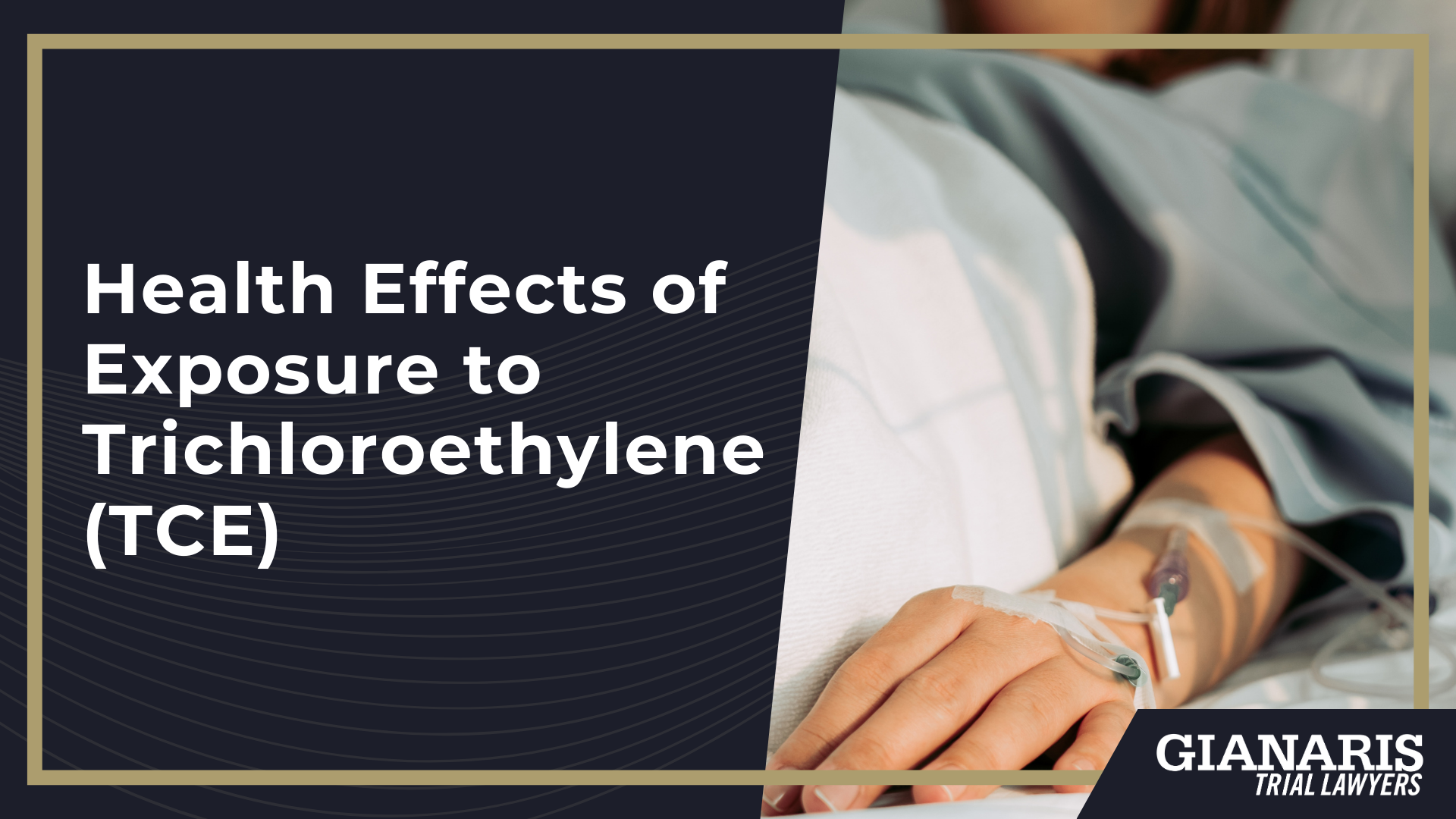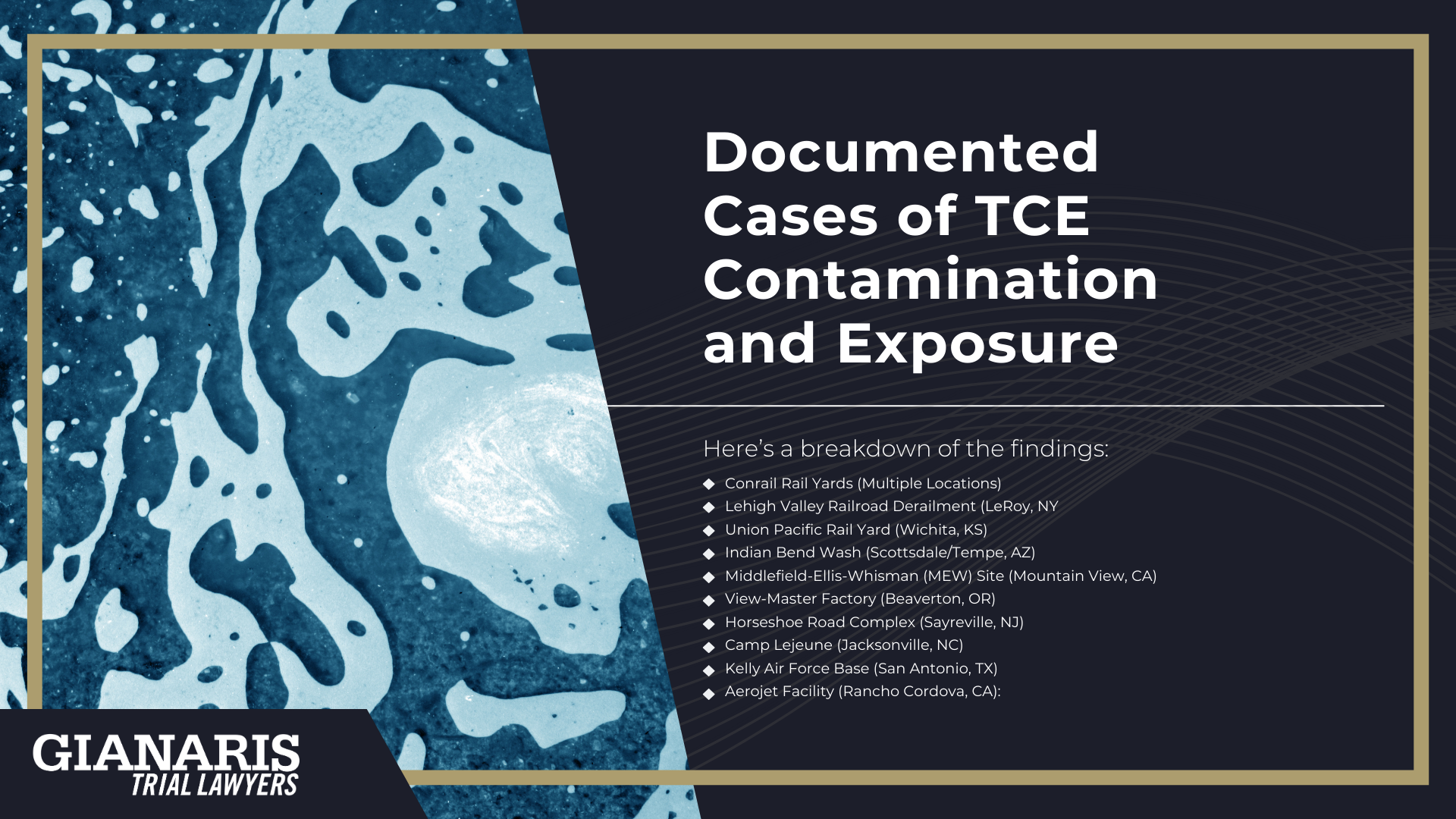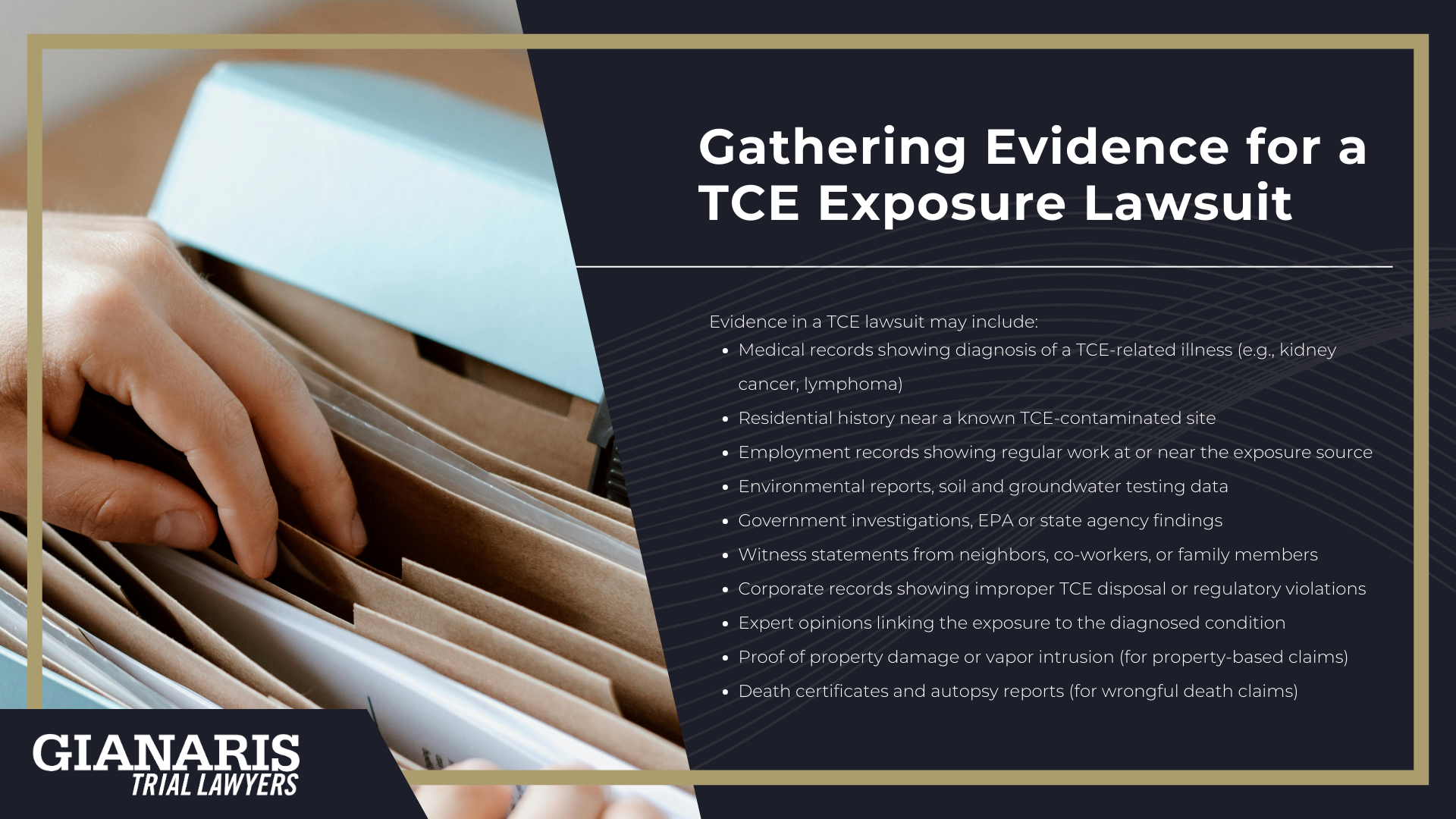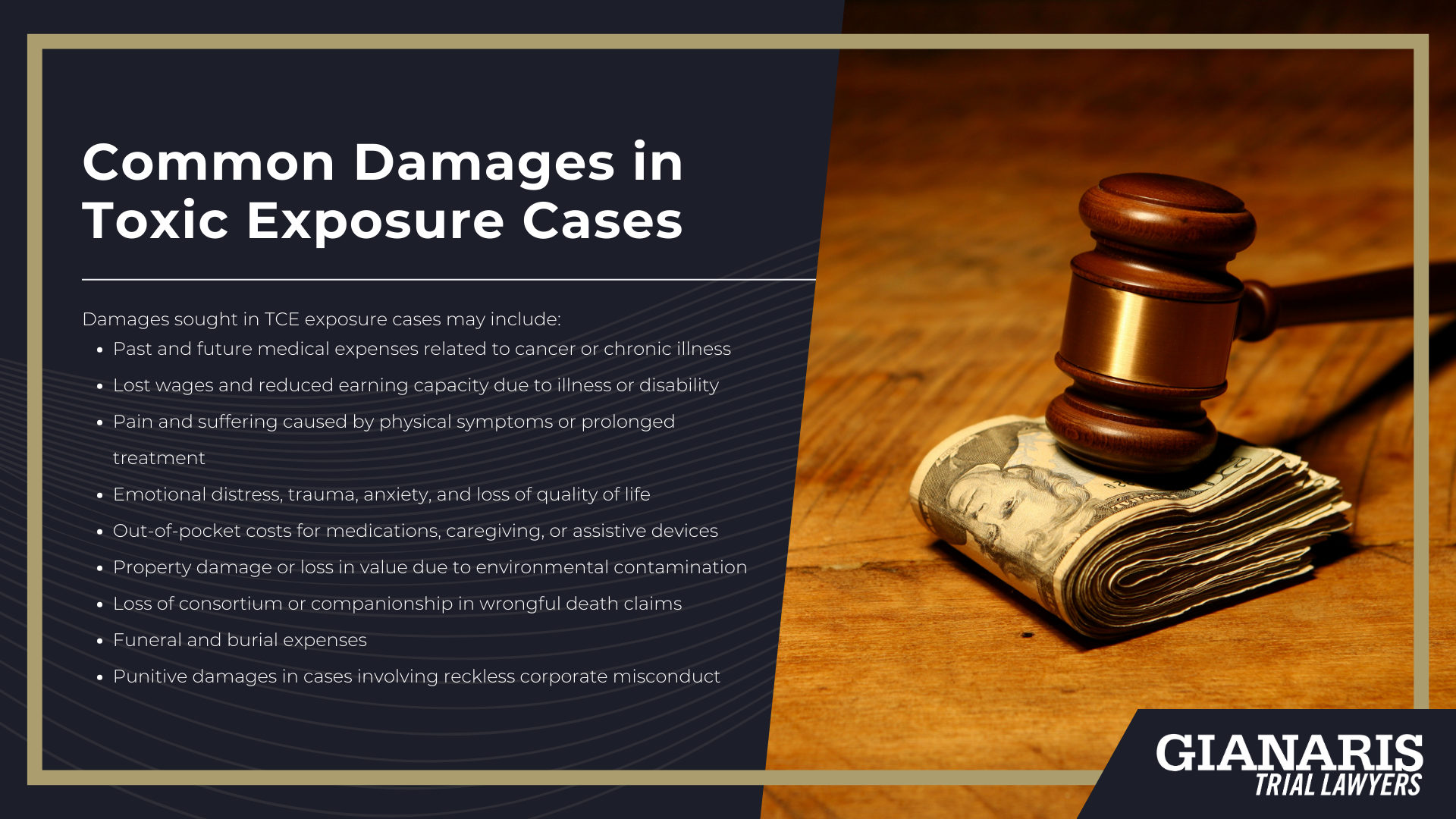Trichloroethylene (TCE) is a volatile, colorless liquid with a somewhat sweet odor, formerly used widely as an industrial solvent and degreaser.
The Environmental Protection Agency (EPA) lists TCE among the most hazardous chemicals regulated under the Toxic Substances Control Act (TSCA) due to its confirmed links to kidney cancer, non-Hodgkin lymphoma, and liver damage, as well as harmful effects on the central nervous system, immune system, liver, kidneys, and reproductive system.
The Centers for Disease Control and Prevention (CDC) and Agency for Toxic Substances and Disease Registry (ATSDR) have documented TCE’s role in both occupational and environmental exposures, listing serious health issues ranging from acute nerve damage to chronic autoimmune-related effects
The National Toxicology Program (NTP) has also classified TCE as a known or probable human carcinogen based on robust animal and epidemiologic evidence.
Although its usage has declined, TCE remains present in many environments, including industrial facilities, legacy manufacturing sites, and contaminated water systems.

Here’s where TCE has historically been used and may still be found today:
- Industrial degreaser for metal parts and machinery
- Vapor degreasing operations in automotive, aerospace, and electronics manufacturing
- Paint removers, adhesives, sealants, and cleaning products
- Spot removers, typewriter correction fluids, and aerosol stainers
- Lubricants, varnishes, and furniture or automotive care products
- Intermediate in the production of refrigerants and other chlorinated solvents
- Contamination in groundwater and soil at industrial and Superfund sites
Despite the decline in commercial use, tens of thousands of sites remain contaminated with TCE, and it continues to affect people through environmental pathways such as vapor intrusion and drinking water contamination.
If you or someone you know worked in industrial settings (especially involving cleaning, maintenance, or solvent use) or lived near contaminated soil or groundwater, exposure to TCE may have contributed to serious health issues.
How are People Exposed to TCE?
Trichloroethylene (TCE) exposure can occur through multiple environmental and occupational routes, primarily involving contaminated water, air, and products.
Because TCE is highly volatile, it readily evaporates into the air from soil and groundwater, where it can infiltrate buildings through a process called vapor intrusion.
This leads to indoor air contamination in homes, schools, and workplaces near polluted industrial sites or Superfund locations.
According to the EPA, TCE is one of the most dangerous drinking water contaminants, making public drinking water contamination a major source of long-term community exposure.
Individuals may also come into contact with TCE-contaminated water during bathing, cooking, or other household uses.
Workers in certain industries (such as dry cleaning and metal degreasing) may face direct exposure to TCE vapors or residues from older equipment or poorly ventilated areas.
Even the use of consumer products like spot removers, typewriter correction fluids, and aerosol cleaners has historically contributed to low-level but consistent TCE exposure in non-occupational settings.
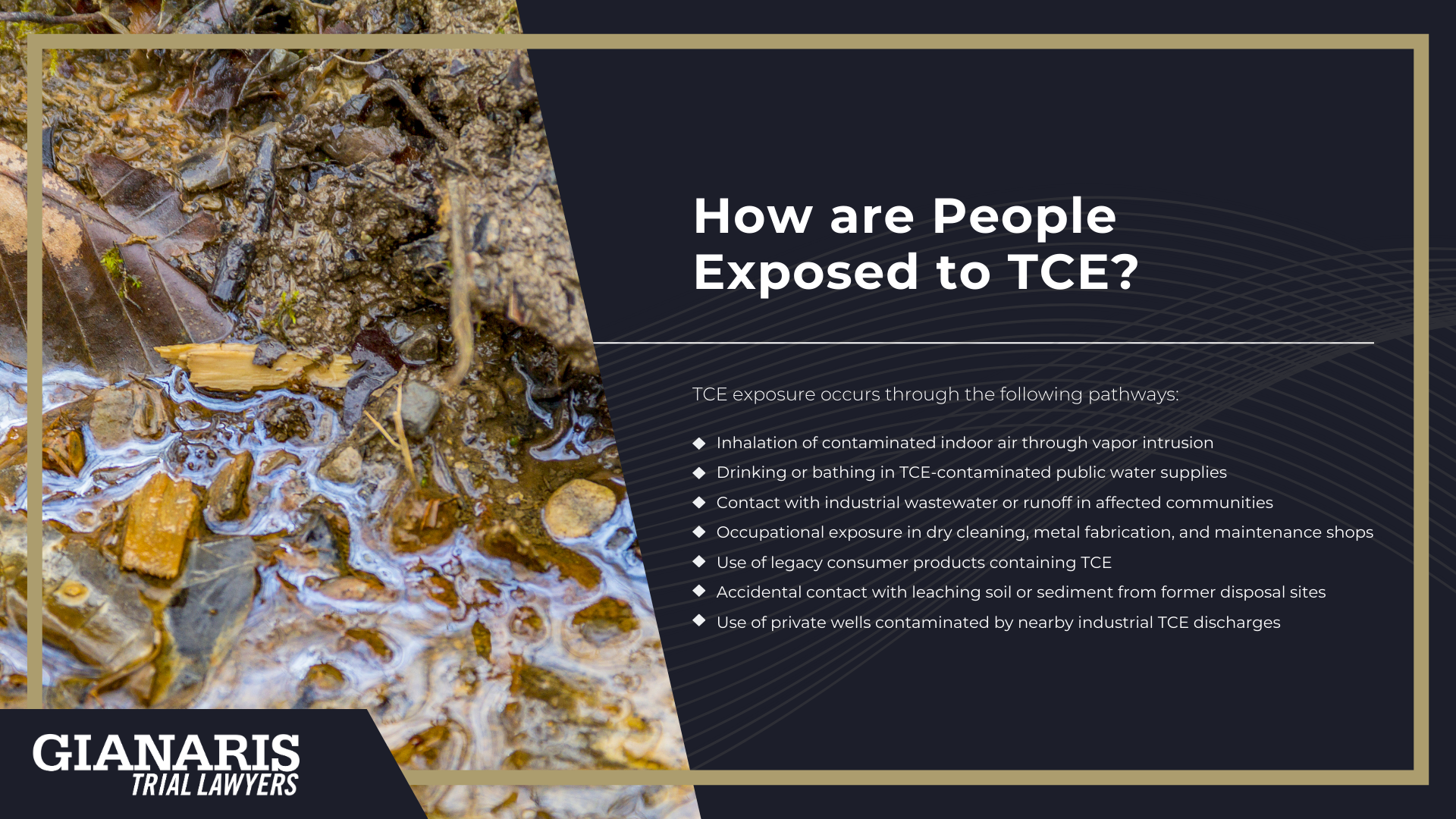
TCE exposure occurs through the following pathways:
- Inhalation of contaminated indoor air through vapor intrusion
- Drinking or bathing in TCE-contaminated public water supplies
- Contact with industrial wastewater or runoff in affected communities
- Occupational exposure in dry cleaning, metal fabrication, and maintenance shops
- Use of legacy consumer products containing TCE
- Accidental contact with leaching soil or sediment from former disposal sites
- Use of private wells contaminated by nearby industrial TCE discharges
These exposure routes are especially concerning due to the compound’s persistence in the environment and its ability to infiltrate homes and buildings unnoticed.
Who is at Risk of Exposure to Trichloroethylene (TCE)?
TCE exposure affects a wide range of people, from workers in industrial settings to individuals living near contaminated sites.
Those most at risk include people who handle or work around degreasers, solvents, or cleaning chemicals, especially in poorly ventilated environments.
Exposure can occur through workplace contact, contaminated air or drinking water, or through historical usage of consumer products.
Families living near Superfund sites, military bases, or former manufacturing plants may also unknowingly face chronic exposure through vapor intrusion or public water contamination.
The risk isn’t limited to industrial workers: service members, hospital staff, and maintenance crews have also been documented among affected populations.
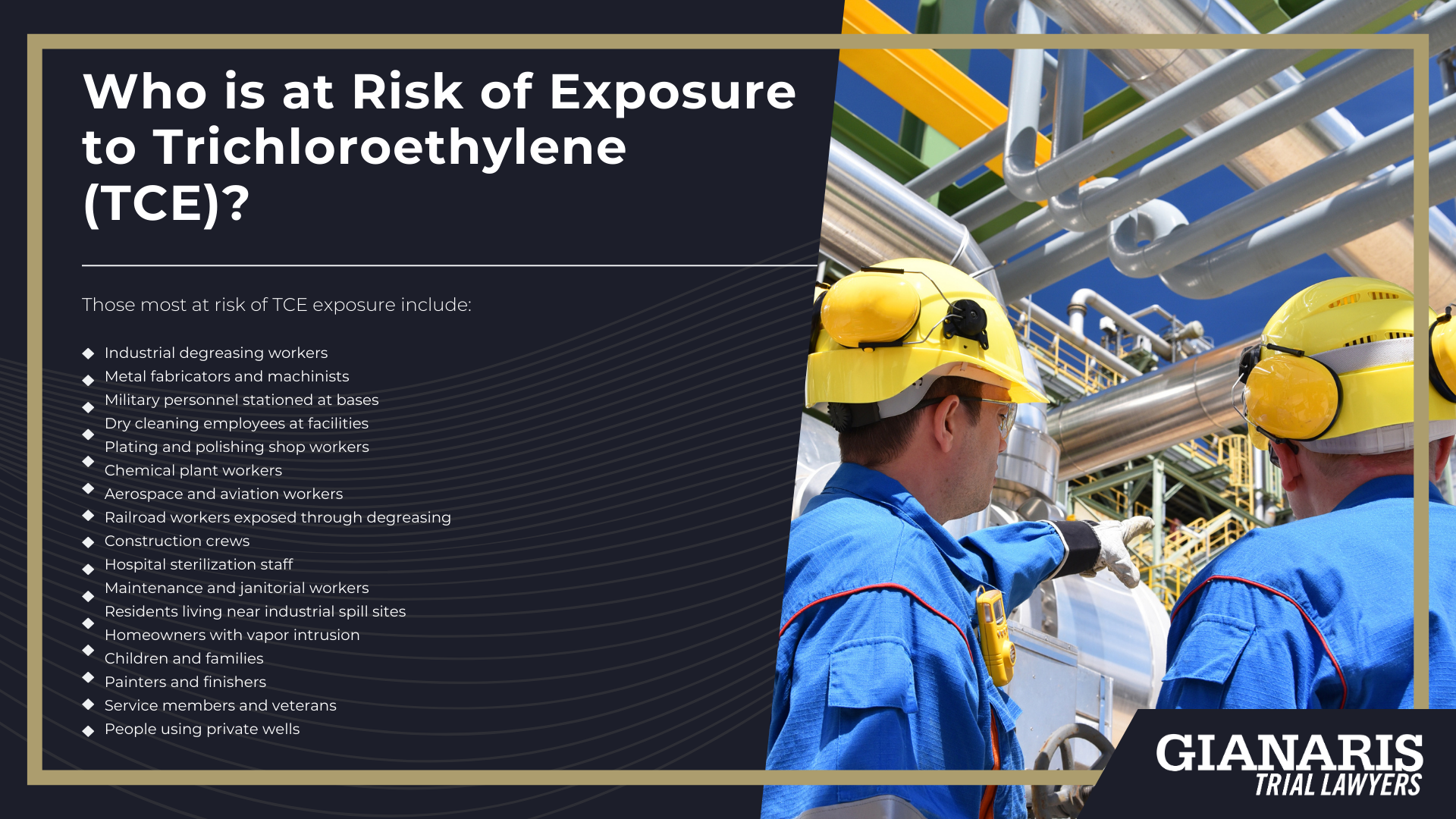
Those most at risk of TCE exposure include:
- Industrial degreasing workers in automotive, electronics, and aerospace industries
- Metal fabricators and machinists who work with parts cleaned using TCE
- Military personnel stationed at bases with known TCE groundwater contamination (e.g., Camp Lejeune)
- Dry cleaning employees at facilities using chlorinated solvents
- Plating and polishing shop workers
- Chemical plant workers involved in TCE production or formulation
- Aerospace and aviation workers involved in component cleaning
- Railroad workers exposed through degreasing equipment and fuel systems
- Construction crews on or near formerly contaminated sites
- Hospital sterilization staff (historical use of TCE in medical equipment cleaning)
- Maintenance and janitorial workers using solvent-based cleaning products
- Residents living near industrial spill sites or Superfund locations
- Homeowners with vapor intrusion from contaminated groundwater
- Children and families relying on public water systems contaminated with TCE
- Painters and finishers using solvent-based materials in confined areas
- Service members and veterans at bases with long-term environmental contamination
- People using private wells near past industrial activity
These individuals may face prolonged or repeated exposure to TCE through inhalation, ingestion, or dermal contact, leading to serious health consequences.
Is Trichloroethylene (TCE) Banned in the United States?
The EPA has taken decisive action to prohibit the vast majority of trichloroethylene (TCE) uses under the Toxic Substances Control Act (TSCA).
In December 2024, the EPA issued a final rule banning the manufacture, import, processing, and distribution of TCE across all uses, reflecting its determination that TCE poses an “unreasonable risk to human health”
Most commercial and consumer applications (including TCE in cleaning products, degreasers, spot removers, and industrial solvents) will be phased out within one year, though limited temporary extensions apply for critical industrial processes
The new rule aligns with EPA’s prior risk evaluations stating that 52 out of 54 uses of TCE pose health hazards, including risks of liver and kidney damage, immunotoxicity, carcinogenicity, neurological harm, and reproductive effects.
However, for now, the rule’s implementation has been delayed due to legal and procedural developments.
A temporary stay (requested by the Fifth Circuit and maintained by the Third Circuit) combined with ongoing regulatory review, has postponed the rule’s effective date.



